Energy Characteristics of a Bidirectional Axial-Flow Pump with Two Impeller Airfoils Based on Entropy Production Analysis
Abstract
:1. Introduction
2. Numerical Simulation
2.1. Three Models and Meshes
2.2. Boundary Condition
3. Entropy Production Theory
4. Results and Discussion
4.1. Test Validation
4.2. Energy Characteristics of the Two Bidirectional Axial-Flow Pumps
4.3. Distribution of Local Entropy Production Rates under the Forward Condition
4.4. Distribution of Local Entropy Production Rate under the Reverse Condition
5. Conclusions
- (1)
- Under the forward condition, the optimal operation point is not affected by the impeller airfoil, and the hydraulic performance of the arc-shaped case is higher than that of the S-shaped case. Under the reverse condition, the hydraulic performance is higher, and the optimal operation point shifts to a small flow rate of the S-shaped case, compared with the arc-shaped case.
- (2)
- Under the forward condition, the TEP of the impeller and the elbow pipe is dominant. The anti-arch form of the trailing edge of the S-shaped suction side creates a barrier effect, which results in higher average TEPR near the region of the hub and the rim compared with the arc-shaped blade. In addition, the TEPR distribution in the elbow pipe is similar for the arc- and S-shaped cases, and the high TEPR can be found near inlet due to a decrease in the rotational kinetic energy along the flow direction.
- (3)
- Under the reverse condition, the TEP of the impeller and the straight pipe is dominant. Due to the large inlet angle of the arc-shaped blade, the flow separation and TEPR near the suction side are stronger and higher, compared with the S-shaped case. Due to the stronger wake vortex, the area of high TEPR in the straight pipe of the arc-shaped case is higher than that of the S-shaped case.
Author Contributions
Funding
Conflicts of Interest
Nomenclature
| Latin Letters | |||
| Time-averaged pressure | Specific entropy | ||
| Time-averaged velocity | Temperature | ||
| Heat flux density vector | Head coefficient | ||
| Flow coefficient | Circumferential velocity | ||
| Rotation speed | d2 | Diameter of impeller outlet | |
| Hub radius | Shroud radius | ||
| EQ | Measurement uncertainty of flow rate | EH | Measurement uncertainty of head |
| ET | Measurement uncertainty of torque | En | Measurement uncertainty of rotation speed |
| R* | Radial coefficient | Entropy production by direct dissipation | |
| Entropy production by indirect dissipation | Total entropy production | ||
| Greek Letters | |||
| Water density | Dynamic viscosity | ||
| Entropy production by dissipation | Entropy production by heat transfer | ||
| Entropy production rate by direct dissipation | Entropy production rate by indirect dissipation | ||
| Abbreviations | |||
| URANS | Unsteady Reynolds time-averaged Navier–Stokes | CFD | Computational fluid dynamics |
| EXP | Experiment | TLV | Tip leakage vortex |
| TEP | Total entropy production | TEPR | Total entropy production rate |
References
- Xia, Y.; Tang, F.; Shi, L.; Xie, C.; Zhang, W. Numerical simulation and experimental analysis of bidirectional shaft tubular pump device. China Rural Water Hydropower 2017, 7, 149–153. (In Chinese) [Google Scholar]
- Shi, L.; Liu, X.; Tang, F.; Yao, Y.; Xie, R.; Zhang, W. Numerical simulation and experimental analysis of bidirectional shaft tubular pump device. Trans. Chin. Soc. Agric. Mach. 2016, 47, 85–91. (In Chinese) [Google Scholar]
- Ma, P.; Wang, J.; Wang, H. Investigation of performances and flow characteristics of two bi-directional pumps with different airfoil blades. Sci. China Technol. Sci. 2018, 61, 1588–1599. [Google Scholar] [CrossRef]
- Ma, P.; Wang, J. An analysis on the flow characteristics of bi-directional axial-flow pump under reverse operation. Proc. Inst. Mech. Eng. Part A J. Power Energy 2017, 231, 239–249. [Google Scholar] [CrossRef]
- Liu, H.; Chen, X.; Wang, K.; Tan, M.; Zhou, X. Multi-condition optimization and experimental study of impeller blades in a mixed-flow pump. Adv. Mech. Eng. 2016, 8, 1687814016651817. [Google Scholar] [CrossRef] [Green Version]
- Heo, M.W.; Kim, K.Y.; Kim, J.H.; Choi, Y.S. High-efficiency design of a mixed-flow pump using a surrogate model. J. Mech. Sci. Technol. 2016, 30, 541–547. [Google Scholar] [CrossRef]
- Wang, W.; Tai, G.; Pei, J.; Pavesi, G.; Yuan, S. Numerical investigation of the effect of the closure law of wicket gates on the transient characteristics of pump-turbine in pump mode. Renew. Energy 2022, 194, 719–733. [Google Scholar] [CrossRef]
- Shi, L.; Zhu, J.; Tang, F.; Wang, C. Multi-disciplinary optimization design of axial-flow pump impellers based on the approximation model. Energies 2020, 13, 779. [Google Scholar] [CrossRef] [Green Version]
- Shi, L.; Fu, L.; Xia, Y.; Tang, F.; Sun, D.; Zhai, L. Influence of Maximum Airfoil Camber Position on Hydraulic Performance of Axial-flow Pump. Trans. Chin. Soc. Agric. Mach. 2018, 49, 148–154. (In Chinese) [Google Scholar]
- Kim, S.; Kim, Y.I.; Kim, J.H.; Choi, Y.S. Three-objective optimization of a mixed-flow pump impeller for improved suction performance and efficiency. Adv. Mech. Eng. 2019, 11, 1687814019898969. [Google Scholar] [CrossRef]
- Suh, J.W.; Yang, H.M.; Kim, Y.I.; Lee, K.Y.; Kim, J.H.; Joo, W.G.; Choi, Y.S. Multi-objective optimization of a high efficiency and suction performance for mixed-flow pump impeller. Eng. Appl. Comput. Fluid Mech. 2019, 13, 744–762. [Google Scholar] [CrossRef] [Green Version]
- Shi, L.; Yuan, Y.; Jiao, H.; Tang, F.; Cheng, L.; Yang, F.; Jin, Y.; Zhu, J. Numerical investigation and experiment on pressure pulsation characteristics in a full tubular pump. Renew. Energy 2021, 163, 987–1000. [Google Scholar] [CrossRef]
- Shi, L.; Zhang, W.; Jiao, H.; Tang, F.; Wang, L.; Sun, D.; Shi, W. Numerical simulation and experimental study on the comparison of the hydraulic characteristics of an axial-flow pump and a full tubular pump. Renew. Energy 2020, 153, 1455–1464. [Google Scholar] [CrossRef]
- Feng, J.; Luo, X.; Guo, P.; Wu, G. Influence of tip clearance on pressure fluctuations in an axial flow pump. J. Mech. Sci. Technol. 2016, 30, 1603–1610. [Google Scholar] [CrossRef]
- Fei, Z.; Xu, H.; Zhang, R.; Zheng, Y.; Mu, T.; Chen, Y. Numerical simulation on hydraulic performance and tip leakage vortex of a slanted axial-flow pump with different blade angles. Proc. Inst. Mech. Eng. Part C J. Mech. Eng. Sci. 2021, 236, 09544062211032989. [Google Scholar] [CrossRef]
- Yang, F.; Li, Z.; Yuan, Y.; Liu, C.; Zhang, Y.; Jin, Y. Numerical and Experimental Investigation of Internal Flow Characteristics and Pressure Fluctuation in Inlet Passage of Axial Flow Pump under Deflection Flow Conditions. Energies 2021, 14, 5245. [Google Scholar] [CrossRef]
- Herwig, H.; Kock, F. Direct and indirect methods of calculating entropy generation rates in turbulent convective heat transfer problems. Heat Mass Transf. 2007, 43, 207–215. [Google Scholar] [CrossRef]
- Kock, F.; Herwig, H. Local entropy production in turbulent shear flows: A high-Reynolds number model with wall functions. Int. J. Heat Mass Transf. 2004, 47, 2205–2215. [Google Scholar] [CrossRef]
- Kock, F.; Herwig, H. Entropy production calculation for turbulent shear flows and their implementation in CFD codes. Int. J. Heat Fluid Flow 2005, 26, 672–680. [Google Scholar] [CrossRef]
- Tao, R.; Zhao, X.; Wang, Z. Evaluating the transient energy dissipation in a centrifugal impeller under rotor-stator interaction. Entropy 2019, 21, 271. [Google Scholar] [CrossRef] [Green Version]
- Deng, Q.; Pei, J.; Wang, W.; Lin, B.; Zhang, C.; Zhao, J. Energy loss and radial force variation caused by impeller trimming in a double-suction centrifugal pump. Entropy 2021, 23, 1228. [Google Scholar] [CrossRef] [PubMed]
- Guan, H.; Jiang, W.; Yang, J.; Wang, Y.; Zhao, X.; Wang, J. Energy loss analysis of the double-suction centrifugal pump under different flow rates based on entropy production theory. Proc. Inst. Mech. Eng. Part C J. Mech. Eng. Sci. 2020, 234, 4009–4023. [Google Scholar] [CrossRef]
- Zhang, F.; Appiah, D.; Hong, F.; Zhang, J.; Yuan, S.; Adu-Poku, K.A.; Wei, X. Energy loss evaluation in a side channel pump under different wrapping angles using entropy production method. Int. Commun. Heat Mass Transf. 2020, 113, 104526. [Google Scholar] [CrossRef]
- Ji, L.; Li, W.; Shi, W.; Chang, H.; Yang, Z. Energy characteristics of mixed-flow pump under different tip clearances based on entropy production analysis. Energy 2020, 199, 117447. [Google Scholar] [CrossRef]
- Shen, S.; Qian, Z.; Ji, B. Numerical analysis of mechanical energy dissipation for an axial-flow pump based on entropy generation theory. Energies 2019, 12, 4162. [Google Scholar] [CrossRef] [Green Version]
- Jia, X.; Yu, J.; Li, B.; Zhang, L.; Zhu, Z. Effect of Incident Angle of Wear-ring Clearance on Pressure Pulsation and Vibration Performance of Centrifugal Pump. Front. Energy Res. 2022, 250. [Google Scholar] [CrossRef]
- Huang, X.; Li, Y.; Liu, Z.; Yang, W. Numerical investigation of flow features in the vaneless region of a centrifugal pump by large eddy simulation. Eng. Comput. 2018, 35, 395–410. [Google Scholar] [CrossRef]
- Lin, P.; Yang, T.; Xu, W.; Zhu, Z. Influence of Different Offset Angles of Inlet Guide Vanes on Flow Characteristics of Centrifugal Pump. Front. Energy Res. 2022, 10. [Google Scholar] [CrossRef]
- Yang, F.; Li, Z.; Hu, W.; Liu, C.; Jiang, D.; Liu, D.; Nasr, A. Analysis of flow loss characteristics of slanted axial-flow pump device based on entropy production theory. Royal Soc. Open Sci. 2022, 9, 211208. [Google Scholar] [CrossRef]
- Yang, J.; Liu, J.; Liu, X.; Xie, T. Numerical study of pressure pulsation of centrifugal pumps with the compressible mode. J. Therm. Sci. 2019, 28, 106–114. [Google Scholar] [CrossRef]
- Yang, F.; Chang, P.; Hu, W.; Mao, B.; Liu, C.; Li, Z. Numerical Study on Pressure Pulsation in a Slanted Axial-Flow Pump Device under Partial Loads. Processes 2021, 9, 1404. [Google Scholar] [CrossRef]



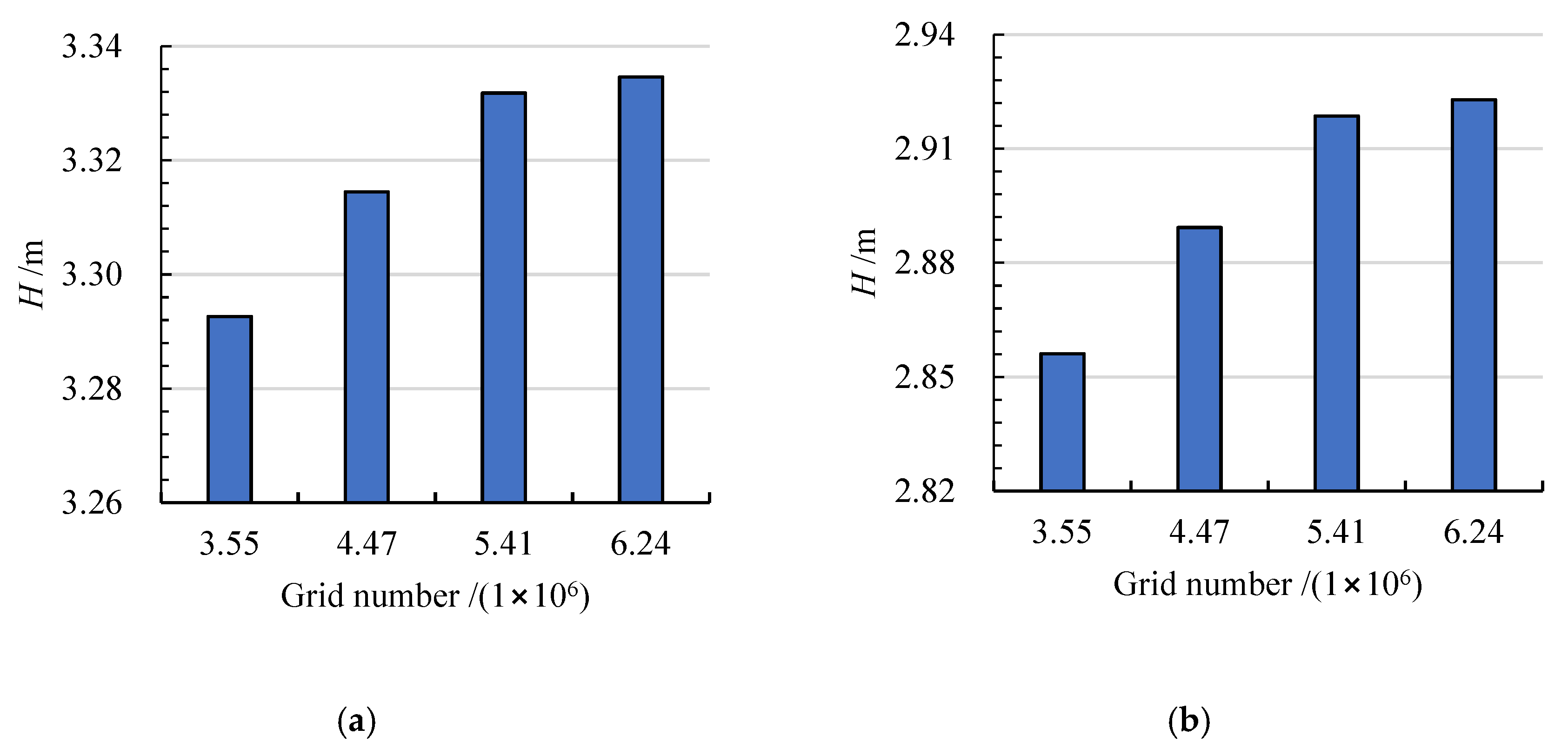
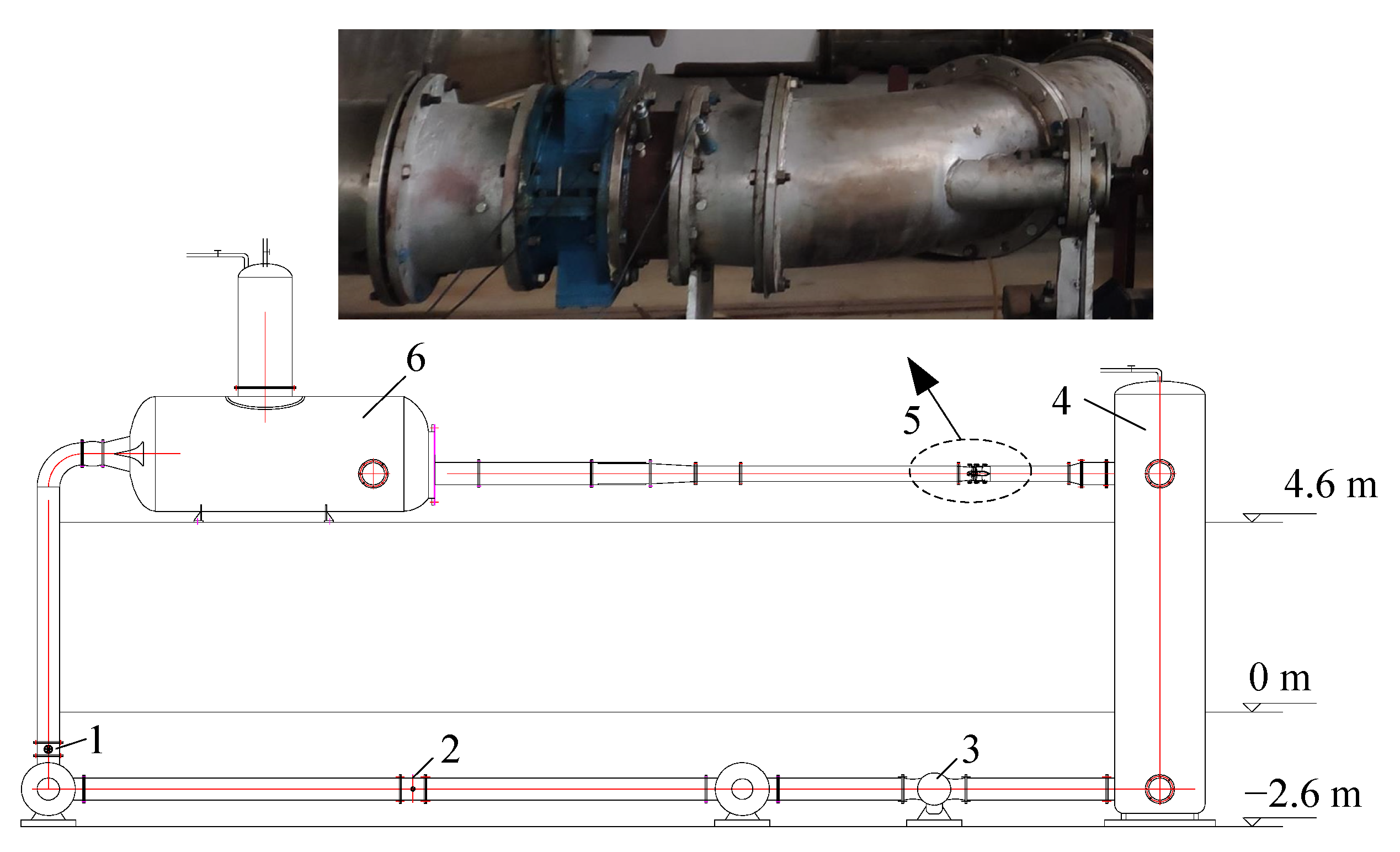
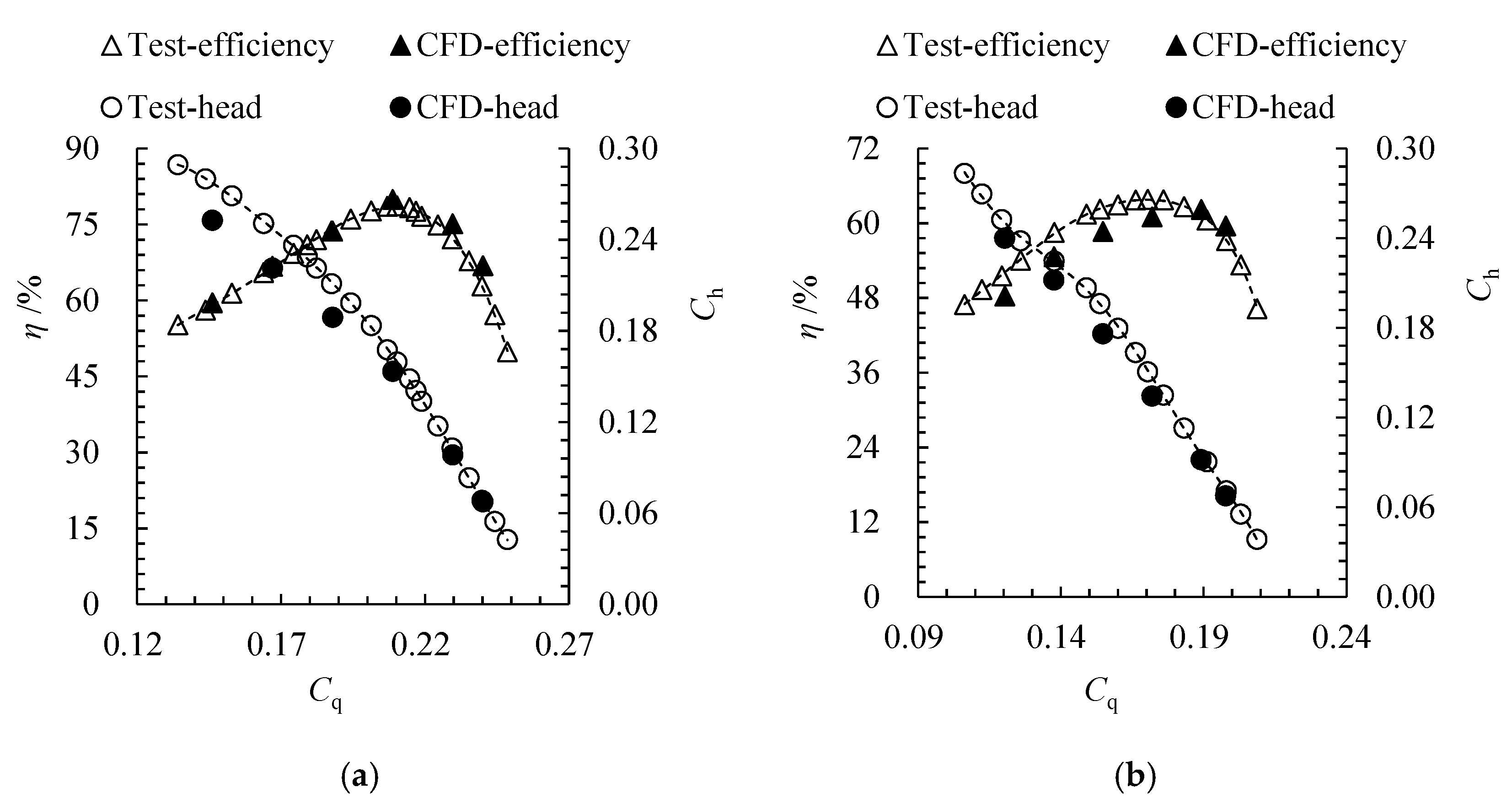
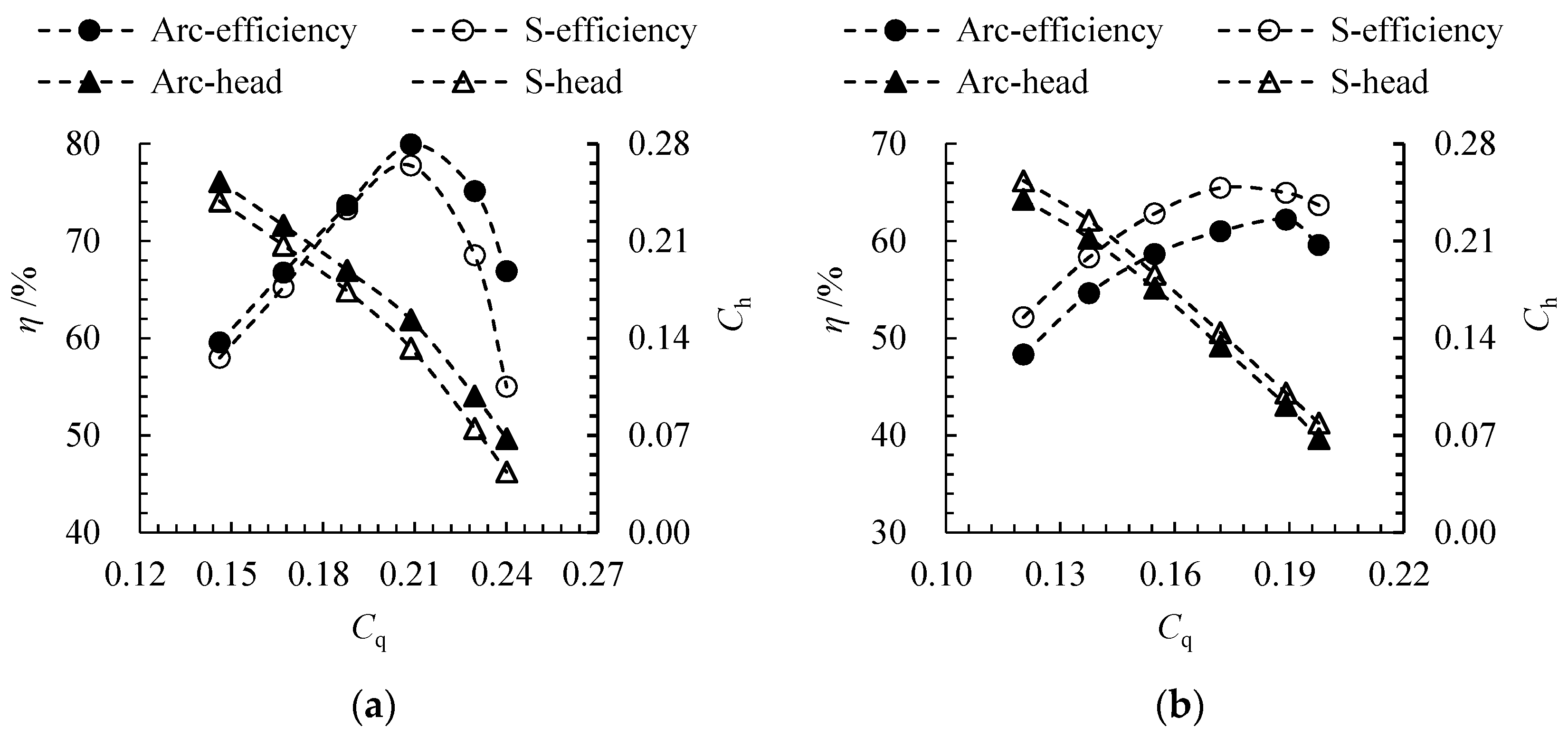
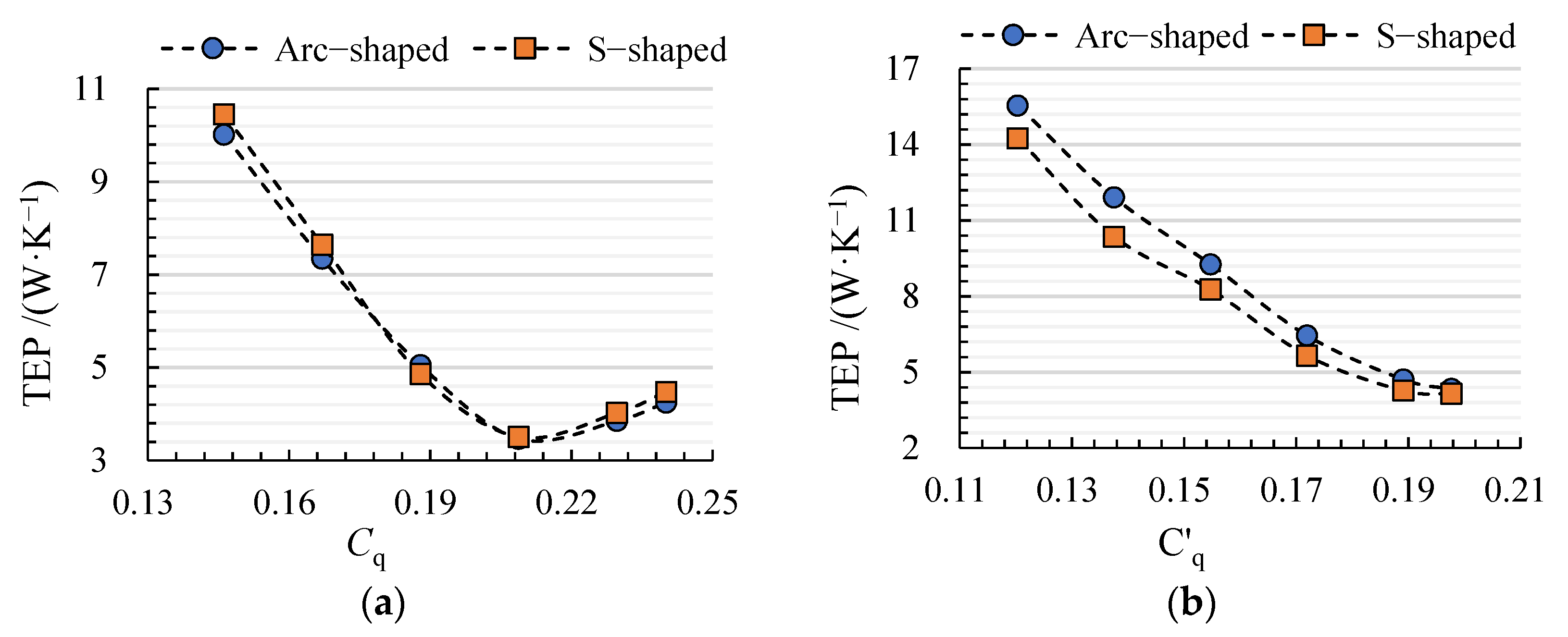
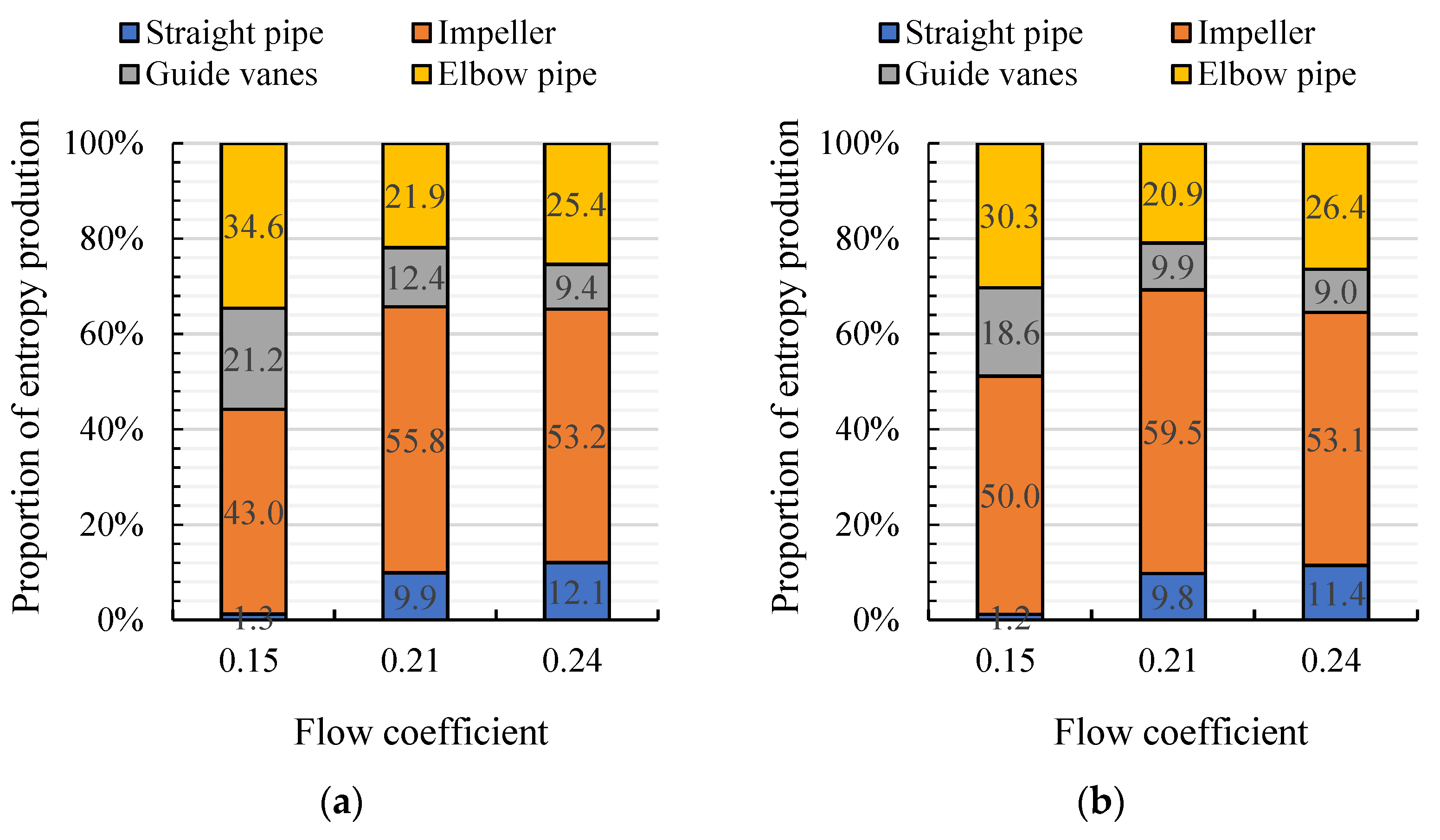


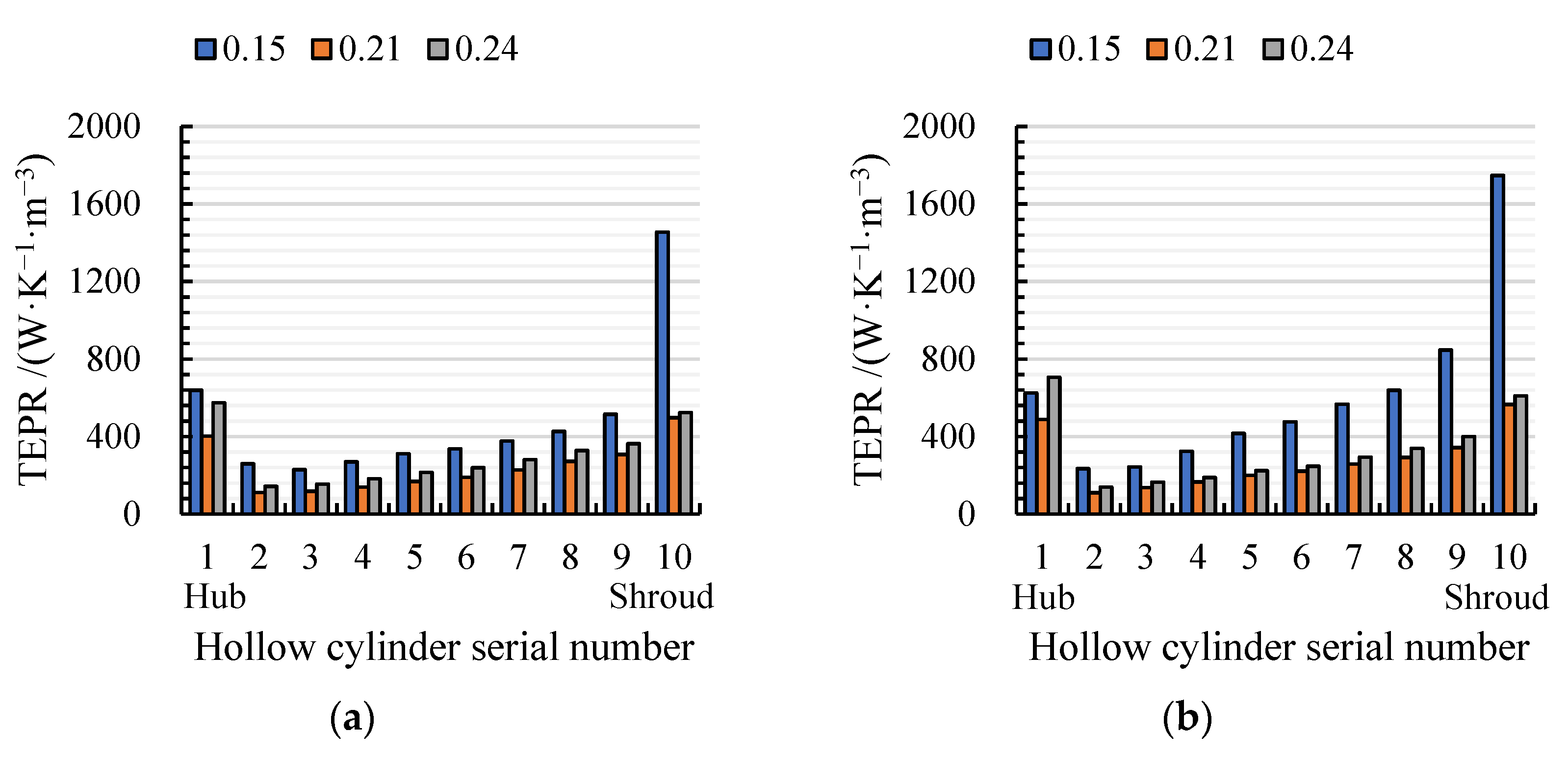
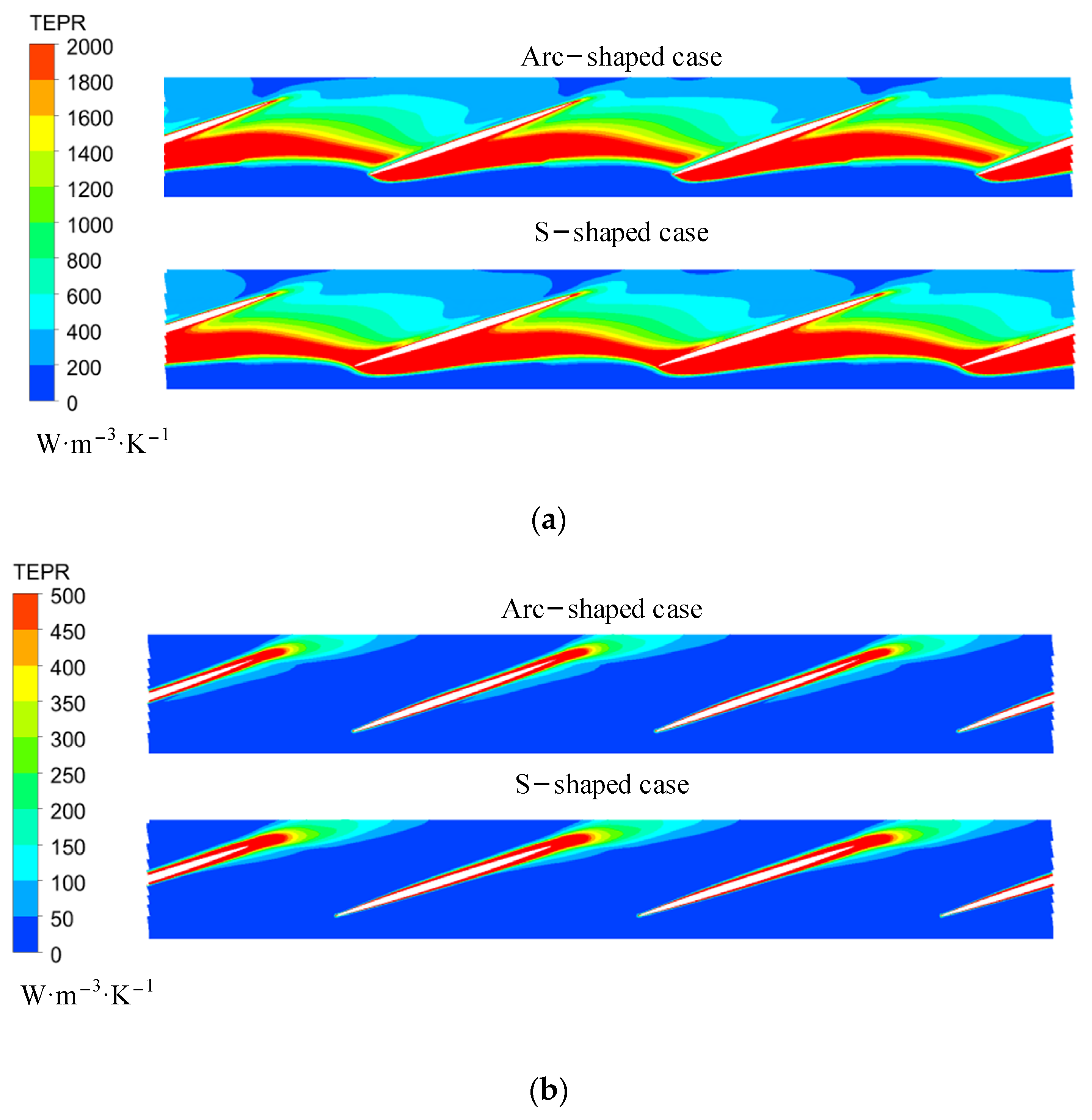
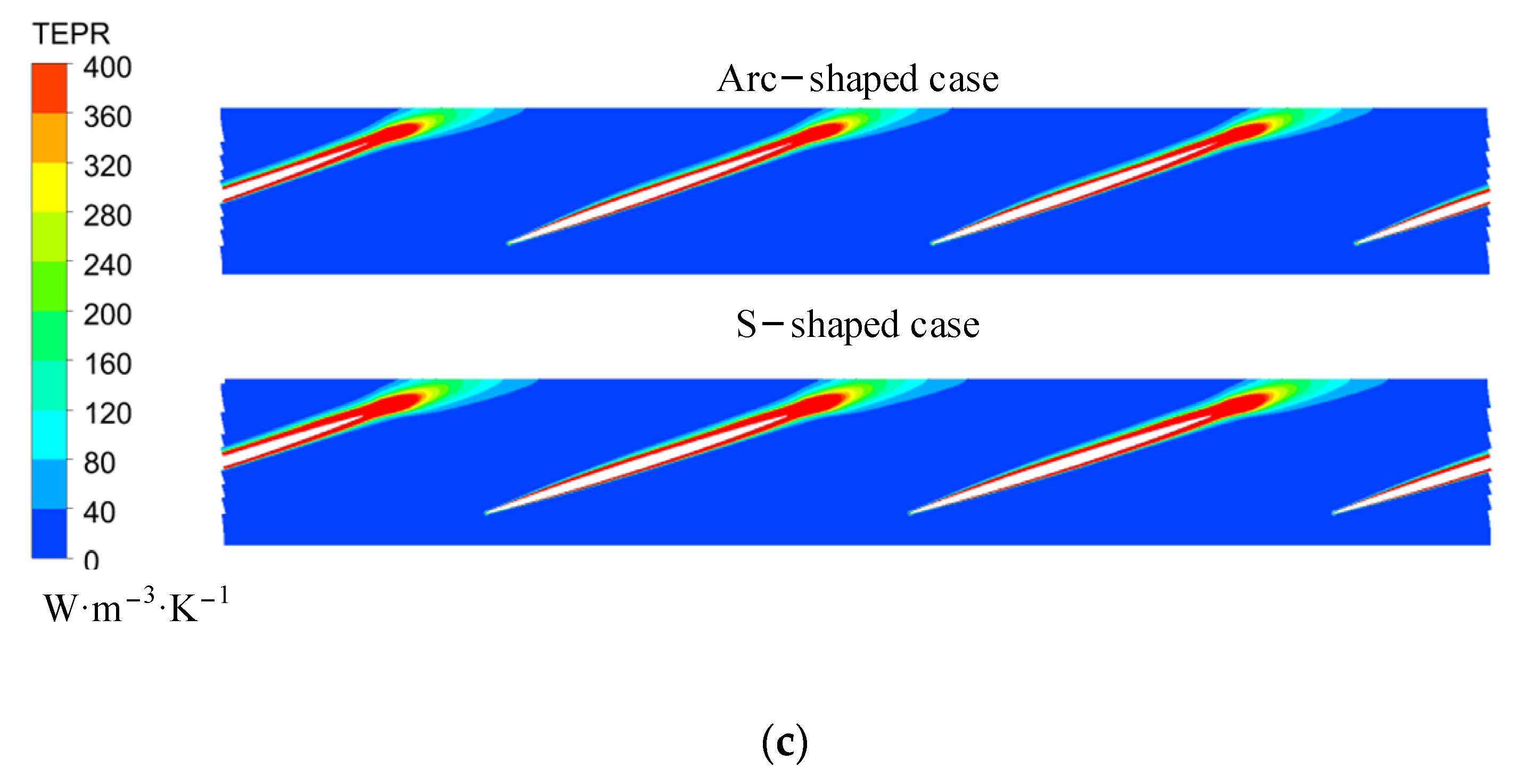


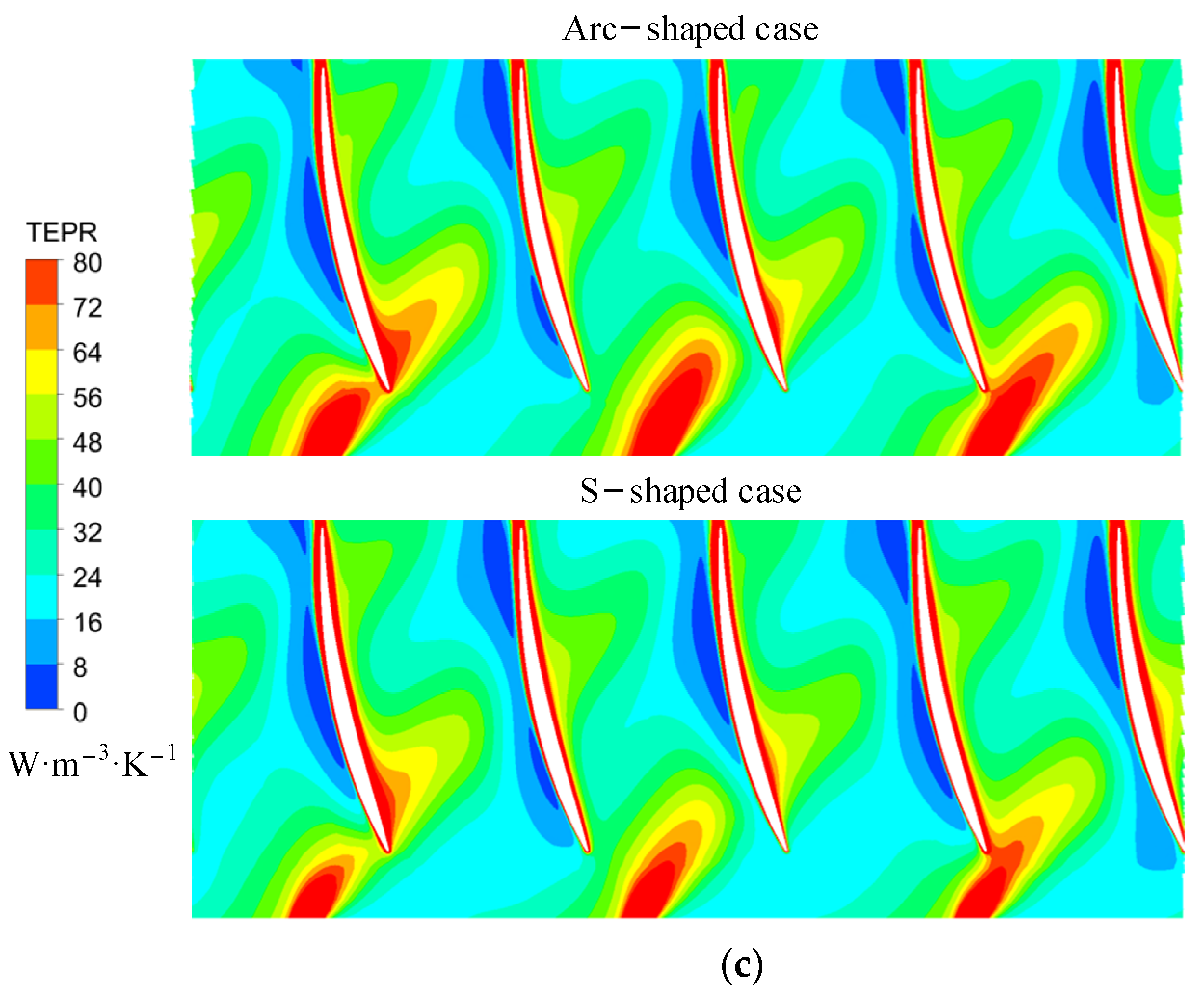
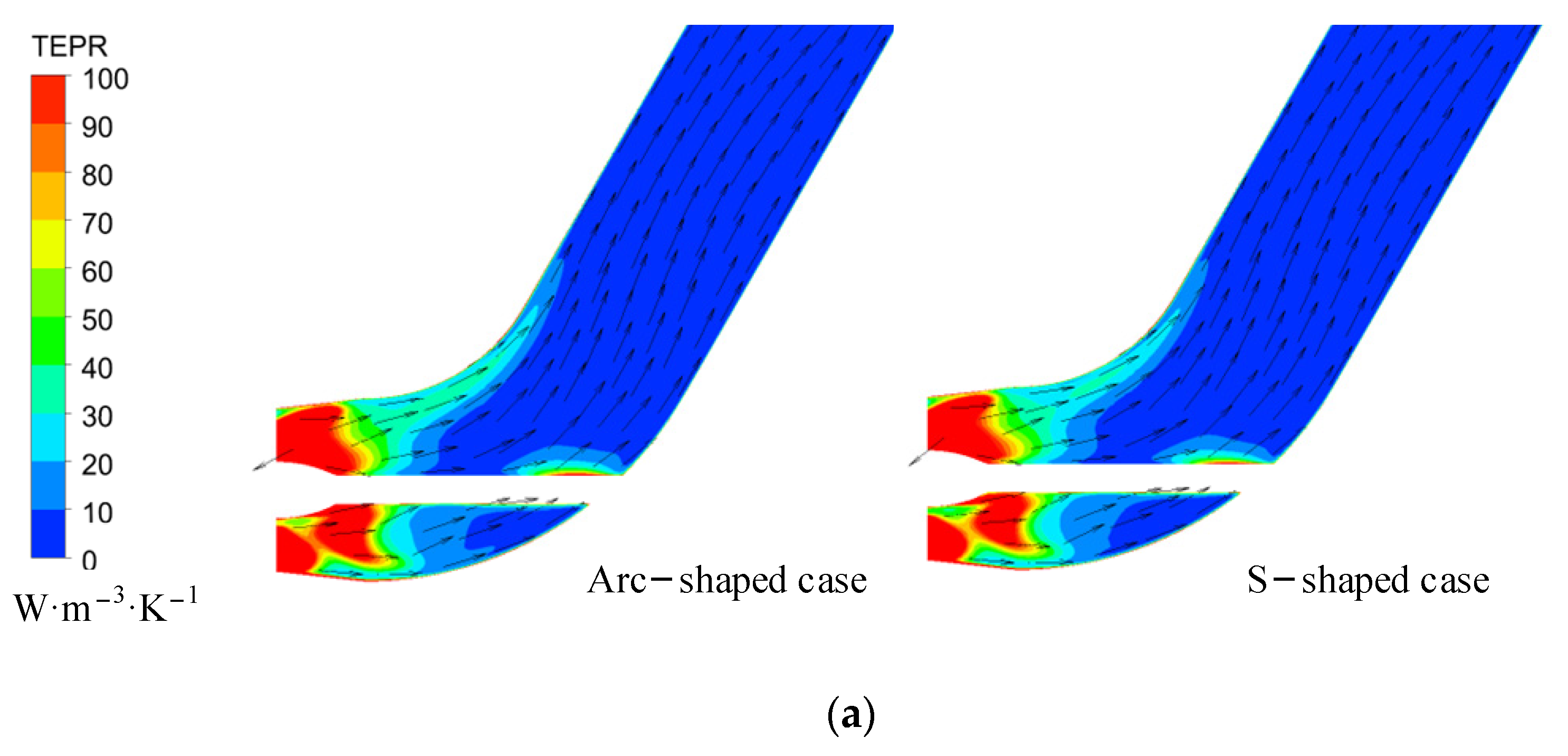
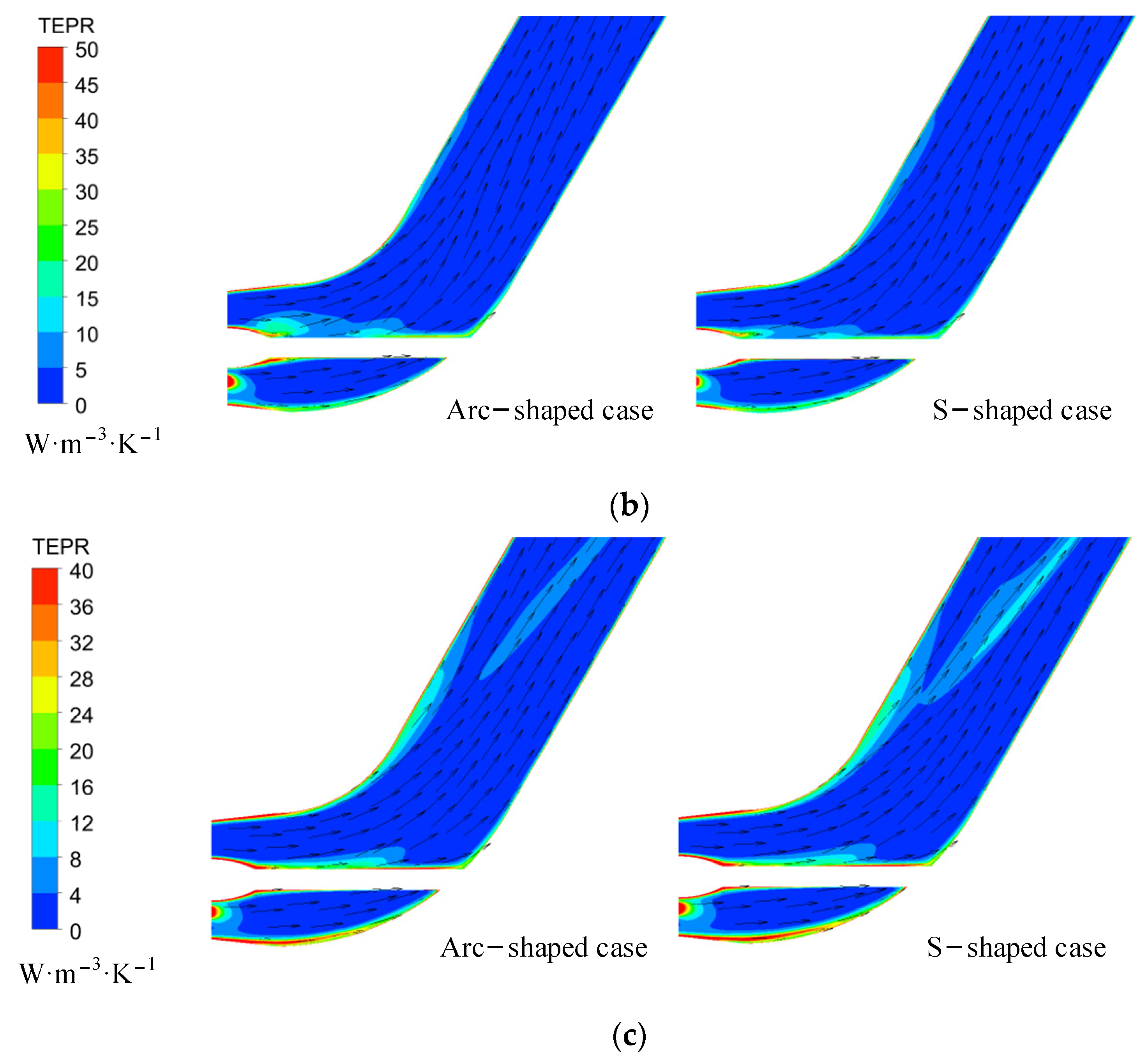

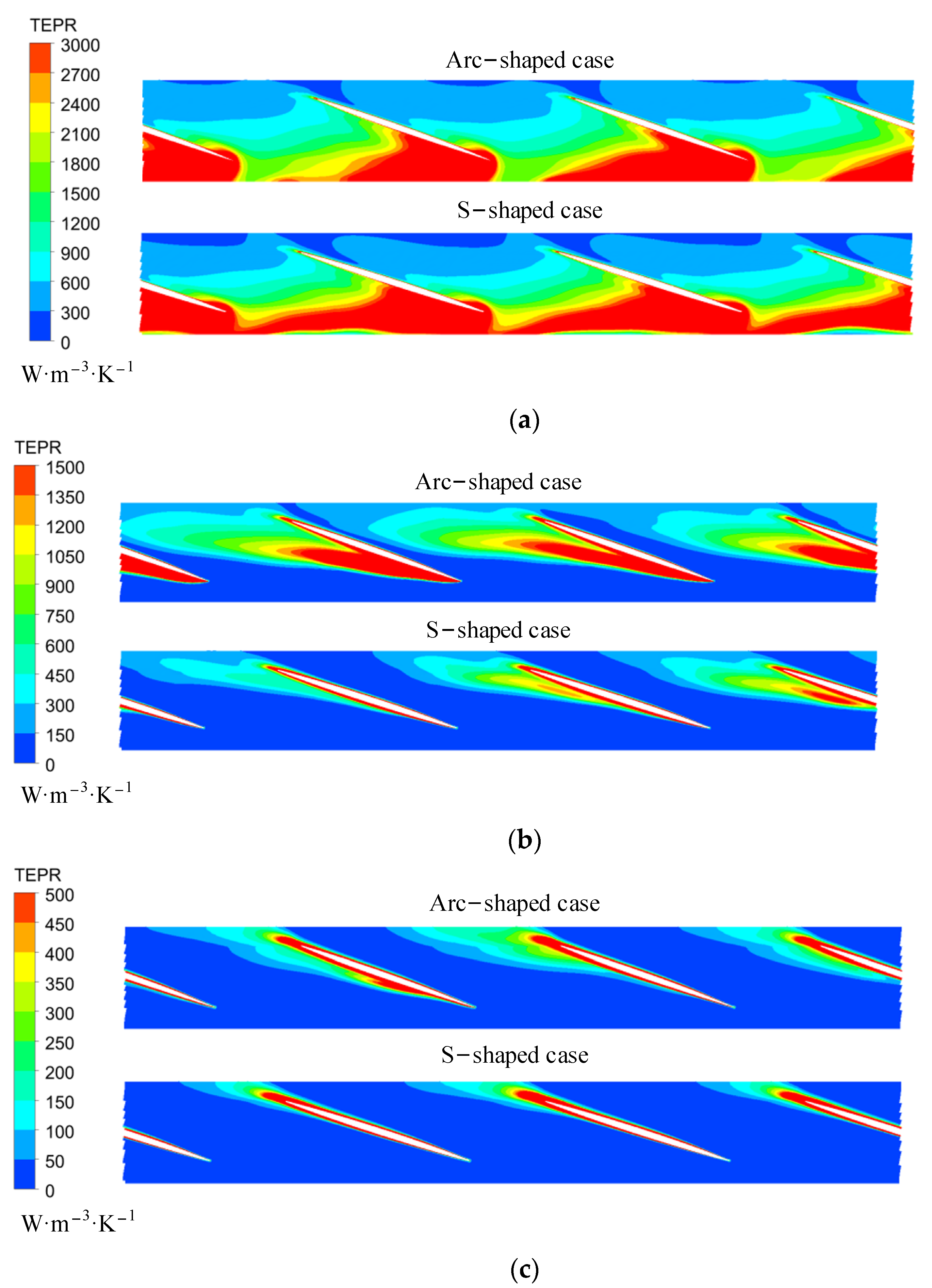

| Parameter | Unit | Arc-Shaped | S-Shaped |
|---|---|---|---|
| Forward-design flow rate | m/s | 0.34 | 0.34 |
| Forward-design head | m | 3.3 | 2.9 |
| Forward rotation speed | r/min | 1350 | 1350 |
| Forward specific speed | 1173.5 | 1292.9 | |
| Reverse-design flow rate | m/s | 0.28 | 0.28 |
| Reverse-design head | m | 2.9 | 3.1 |
| Reverse rotation speed | r/min | 1350 | 1350 |
| Reverse specific speed | 1626.0 | 1116.1 |
| MeasurementItems | Test Instrument | Measurement Range | Measurement Uncertainty |
|---|---|---|---|
| Flow rate | Electromagnetic flowmeter OPTIFLUX2000F | 0~1800 m3/h | = 0.2% |
| Head | Intelligent differential pressure transmitter EJA | 0~10 m | = 0.1% |
| Torque | Intelligent torque speed sensor JCL1 | 0~200 N·m | = 0.1% |
| Rotation speed | = 0.1% |
Publisher’s Note: MDPI stays neutral with regard to jurisdictional claims in published maps and institutional affiliations. |
© 2022 by the authors. Licensee MDPI, Basel, Switzerland. This article is an open access article distributed under the terms and conditions of the Creative Commons Attribution (CC BY) license (https://creativecommons.org/licenses/by/4.0/).
Share and Cite
Meng, F.; Li, Y. Energy Characteristics of a Bidirectional Axial-Flow Pump with Two Impeller Airfoils Based on Entropy Production Analysis. Entropy 2022, 24, 962. https://doi.org/10.3390/e24070962
Meng F, Li Y. Energy Characteristics of a Bidirectional Axial-Flow Pump with Two Impeller Airfoils Based on Entropy Production Analysis. Entropy. 2022; 24(7):962. https://doi.org/10.3390/e24070962
Chicago/Turabian StyleMeng, Fan, and Yanjun Li. 2022. "Energy Characteristics of a Bidirectional Axial-Flow Pump with Two Impeller Airfoils Based on Entropy Production Analysis" Entropy 24, no. 7: 962. https://doi.org/10.3390/e24070962





